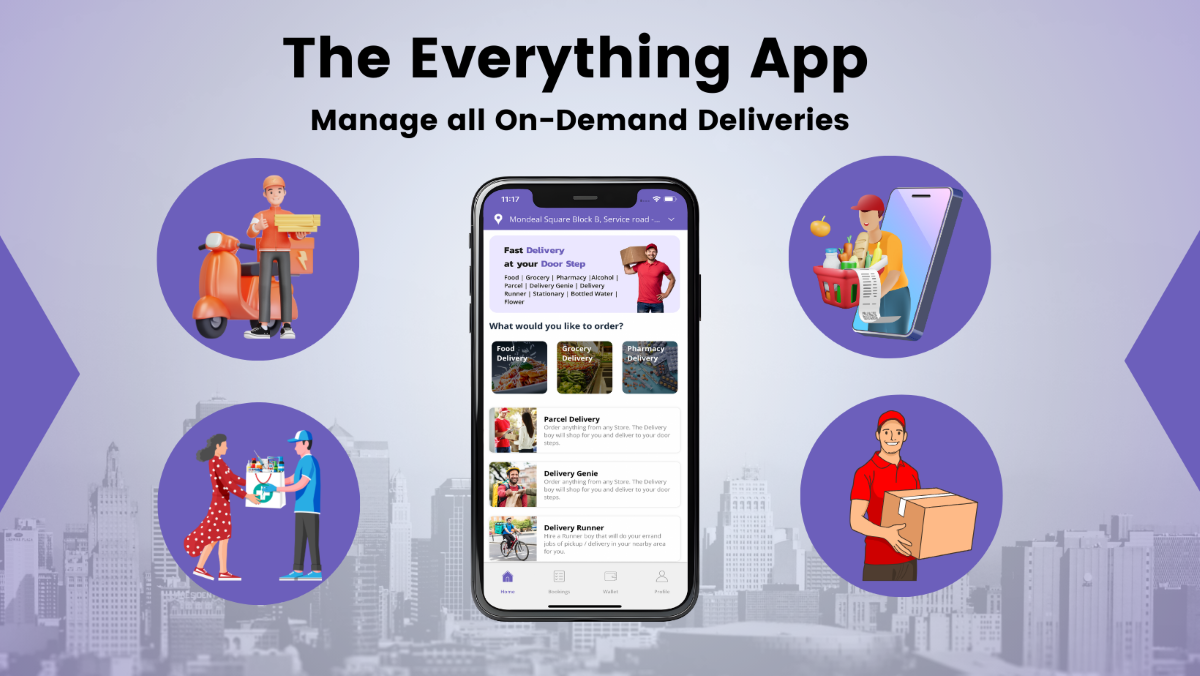The on-demand economy has exploded in recent years and has culminated in the “The Everything App” concept. This innovative concept will change everything there is written about app development. In this blog, look closely at what you’ll accomplish if you create an app capable of providing multiple services on a single platform!
Introduction
What happens when you realize you’ve run out of something? It could be a key food ingredient or an essential file that you’d have forgotten at home. Let’s step outside the home. Consider going to therapy. How will you get there if you don’t have a car? Moreover, how will you schedule the session with the therapist if your plans change?
Indeed, some apps will deliver almost anything an individual needs with just a few taps on their phone. However, the question is how effectively one app truly delivers everything. It may sound farfetched, but there are “everything apps” that have made it possible for people to book all the services much more easily and efficiently.
Just look at how rapidly delivery services have evolved and specialized over the last few years. Rappi in Latin America, Careem in the UAE, Gojek, and Grab in Southeast Asia are all super apps that amass billions of orders monthly. Whether it’s video consultation, getting a cab, or simply ordering food, an everything app offers almost all types of on-demand deliveries. Let’s understand its business model:
The Business Model
Developing a sustainable business model is key to the Everything app’s viability and functionality. From charging commissions to offering subscription plans, the app has the potential to help you gain an enormous market share in the on-demand economy. At its core, it offers delivery services. In other words, there are multiple elements attached to a delivery process.
Furthermore, you, as the app owner, get the money flow via the delivery charges, cancellation charges, and actual order charges. For instance, if one of your app users’ has bought medicine from a pharmacy, the pharmacy will get order details and payment confirmation, which will be later sent to the delivery driver to complete the order.
Such a model has been commonly followed in every app-based on-demand business. Both in terms of financial and qualitative sense, having “The Everything App” based business works perfectly fine under increasing customer load.
Massive Market Opportunity
When you add in grocery, alcohol, retail, and all the other delivery markets, an all-in-one app has access to a market worth hundreds of billions per year and rapidly growing. An app that can capture even a small fraction of this huge opportunity across multiple delivery verticals can build an enormously valuable business.
Moreover, the marginal cost of adding other on-demand services is relatively low once the underlying app infrastructure, technology, and delivery driver network are built out. This will allow your app to rapidly expand in terms of the number of services and the new delivery markets you operate in without massive cost increases.
Building for the Future
“Everything App” development refers to having a holistic product vision that brings together different consumer app verticals into connected experiences. The app offers a one-stop solution for all aspects of consumers’ needs, beyond just delivery services. To launch your Everything App, the technology architecture and design choices made must have scalability as a key priority from the beginning. The code base, backend servers, data pipelines, and other infrastructure should be built keeping in mind flexibility, performance, and rapid extensions to new products.
The Key to Rapid Development – Clone App Scripts
While an all-in-one delivery app holds great promise, developing a polished and fully functional multi-vertical app from scratch requires significant time and investment. This is where using a cloned app script can help shorten the development journey tremendously.
Faster Time-to-Market
An app clone allows startups and new businesses to launch their all-in-one delivery apps faster instead of coding from zero and spending months in development. It provides a ready-made structure that’s integrated with user-friendly interfaces, introduction screens, admin dashboards, and basic functionalities. They can quickly launch the app as compared to building it from the ground up.
Advanced Features and Customization
While cloning gives a pre-built structure, businesses still get plenty of opportunities to customize the delivery app as per their needs, business model, and target audience. Expert developers can easily modify designs, themes, and interfaces, add innovative features, and integrate advanced technologies like AI, ML, and data analytics.
Lower Costs and Risks
Developing an Everything delivery app from the ground up is simply out of reach for many new startups in terms of the costs and risks involved in designing a complex system architecture that scales. Getting a cloned app with robust features allows startups to control their expenses. The proven business model also unlocks access to investor funding faster.
Using a clone script allows new entrants to start with an enviable head start in the on-demand delivery space with lower costs and risks. Combining this strategic leverage with custom innovations and strong operations can lead to building a successful all-in-one delivery business.
Conclusion
While ambitious and complex, The Everything App has a truly unique value proposition in streamlining fragmented delivery apps for consumers. Plus, the unified model proposed raises the bar for convenience in the on-demand economy by utilizing partnerships and intelligent algorithms.

